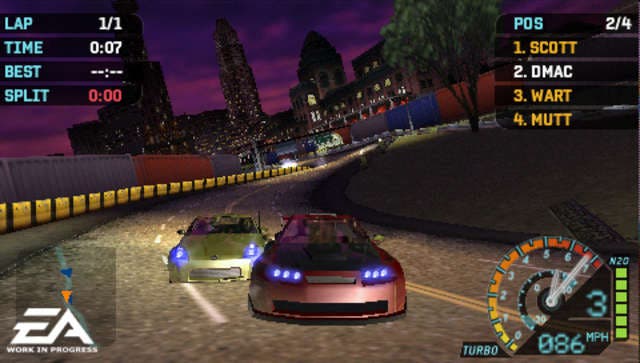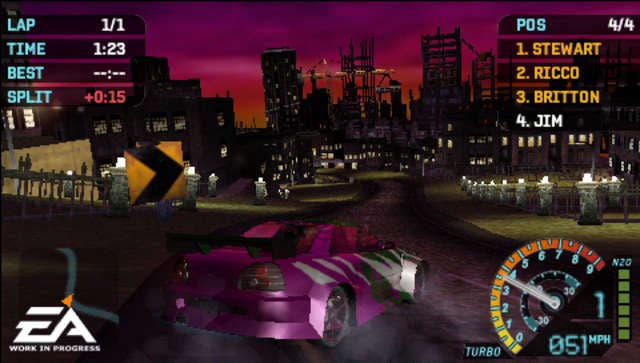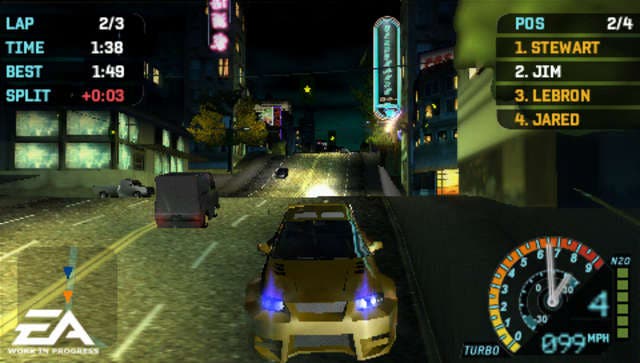Need For Speed Underground: Rivals
No rival to Ridge Racer.
Almost ten years ago, my dad came bursting into our living room like a deep-space marine in Berserk mode. He entered at such speed that there may well have been nitrous leaving his rear end. "Ronan," he said in a voice nothing like Mario's, "It's time you learned how to drive!"
Three hours later, cursing F-Zero under my breath, I realised that games really couldn't prepare you for the reality of gear sticks and clutches. And irate fathers certainly don't match up to that blonde one from OutRun. Except, perhaps, in the arm-waving department. The point is, Need for Speed Underground Rivals reminded me why learning to drive is bothersome: controls. Or more specifically, the sense of control.
By now, we all know that current advocates of the racing genre tend to fall into two camps - the car lovers, and the thrill-seekers. The car lovers will often accept frustrating gameplay issues and tedium so long as the chassis is classy, much like Pro Evo fans accept its pinball effect in the face of the game's overall brilliance. The thrill-seekers, meanwhile, don't really care what the mode of transportation is, so long as the game excites them on some level, be it through speed, or decent AI, or weapons.
Dragged down
Rivals, like most of the Need for Speed series, straddles the line between those two categories, but in this case crosses the line on the issue of controls. Put simply, the analog nub is implemented badly enough to drag the overall game down, especially when compared to the likes of Ridge Racer or even WipEout Pure, a series in which controls have always been a stickler.
Now, that's not to say that nub control in Rivals is appalling, because that's not the case. It's just that when compared with other top racing games on the PSP - of which there are many already - the difference is noticeable, even when you upgrade your cars. In Rivals, the dead zone is far too big and, naturally enough, detracts from gameplay as a result. Thankfully, digital control is much more accurate, but surely the majority of gamers these days have no interest in d-pad driving?
Issues of control and comfort are paramount to any racing game, but even more so in handheld gaming. The PSP's annoying influx of ports and established brands has been a blessing in disguise, because handheld games are judged (or should be) under very different criteria. A handheld game should always get the basics right, because players are likely to be limited to stop-start sessions in which immediate satisfaction should be the priority. I can honestly say that had Ridge Racer PSP been released on the PS2 instead, I would never have spent so much time with it. The same goes for the likes of Lumines and even Virtua Tennis, considering its age.
Cut to the chase

On this level, Rivals does a lot of things right. It drops the free-roaming city style of the other Underground games, along with the - ahem - story modes. It cuts through most of the pap and lets you get straight into the meat of the game. It offers a variety of modes, nearly all of which can be played for just a few minutes at a time, and it doesn't mess about with gangsta prankstas.
The basic premise will be familiar to anyone who has played a current-gen racing game - you race, progress to harder levels, earn points and unlock new cars. In the case of Rivals, as with the Underground series as a whole, you also get to upgrade your cars both visually and practically. While it's always pleasing to change the way your car looks, the impact isn't as prominent on the PSP, because the car models seem less detailed than on the PS2 and certainly aren't as visible on the smaller screen. Plus, visual upgrades can only be unlocked by winning races, so customisation feels somewhat restricted initially, although EA must be applauded for implementing such minute details as rims and pipes in an already, well, exhaustive process. Also, while the performance upgrade system is addictive and satisfying, it can take a bit of trial and error to discover all the effects each upgrade has on a car.
You can safely guess, for example, that the 'engine' upgrade will affect top speed and acceleration, but options like 'drivetrain' or 'intake and exhaust' can take a little more experimentation. Thankfully, with only three basic car attributes to consider (acceleration, top speed and handling) that isn't too much of a problem.
Circuit bored

Rivals lacks an out-and-out career mode, with the closest option to that affect being the Circuit Race mode. A Circuit Race basically amounts to racing laps around a course and trying to finish first - what'll they think of next?! - with four difficulty modes to choose from and bronze, silver and gold medals to win at each level. This mode is actually more difficult than it sounds, especially if you choose the cheapest (and subsequently worst) car as your first purchase.
While the racing itself is afflicted with the aforementioned control issues, there are a number of other annoyances in the basic design. Random 'traffic' cars - like sparser versions of those in the Burnout series - have a tendency to block your way at the most inappropriate moments, stopping your car in its tracks, as does the slightest bump from scenery. While it's a bit trite to complain about obstacles in a racing game, these cars sometimes come across the screen, making avoiding them virtually impossible, and the lack of precision in the controls makes veering around them more difficult than it should be. Nonetheless, Circuit Races are often challenging - especially on harder difficulties - even if it's for the wrong reasons at times. A lot more challenging than the majority of Ridge Racer, for example.
Also available under Circuit Race mode is Lap Knockout, where the driver in last place at the end of every lap is eliminated, and the novel Rally Relay, where you race two laps in two separate cars from your garage. Both these options add some much-needed edge to the modes available, especially for people who want five minutes of excitement on the bus when their partner isn't around to oblige.
Stalled

Even better for that is Quick Play Battle, which doesn't really involve a battle at all. Instead, it offers four modes of play that focus less on racing and more on precision and skill. Drift Attack, for instance, challenges you to 'slide' through a succession of semi-circular grids on the track within a time limit, with points awarded for speed and a lack of errors. This is based on the game's 'e-brake' system, which is the equivalent of drifting in Ridge Racer or Burnout, and is executed by tapping the R Trigger. It's only as enjoyable as it sounds. Not very, then.
A little better is the Drag mode, which is reminiscent of the racing mini-game in Knights of the Old Republic [this link once descended into a "mind-tricked out" gag, which has been cut for obvious reasons. - The Management]. Drag mode is all about maintaining speed on a straight-line track, shifting up a gear when an indicator turns green and avoiding the odd obstacle or two. This is actually pretty compelling, but the outcome is usually a dead cert after the first five seconds or so - you either get off to the right start and win, or you'll never catch up.
Nitrous Run, meanwhile, involves 'boosting' from point to point using the nitrous feature, with the nitrous being refilled each time you reach the checkpoints. This, too, is extremely straightforward, but fairly enjoyable when you have ten or fifteen minutes to spare, though you'll need a nitrous system installed on a car in order to access it.
Need For Speed: Street

The best of the four Quick Play Battle modes is probably the Street Cross option, where you race on tight, short tracks with a plethora of twists and difficult turns to take. In fact, this mode is perhaps preferable to the Circuit Races, because you never reach very high speeds, which makes precision turning a little easier with the nub.
In fact, in the end, how much you'll enjoy Rivals may well depend on that particular issue. If you haven't played the likes of WipEout Pure or Ridge Racer on the PSP, then maybe the nub of the issue won't be an issue at all. Translation: maybe the shoddy controls won't even bother you. Alternatively, if you're willing to use the d-pad, Rivals is a decent game that has an interesting mix of car customisation, skill-based driving and reasonable speed. If you can look past the jaggy car models and now traditional EA Trax music selection, it might be the ideal travelling companion for fans of the series.
Strip the game of its modes, however, place it next to Ridge Racer for a one-lap test drive and it soon becomes clear that Namco's effort gets the fundamentals almost perfectly right, while Rivals just doesn't feel as comfortable or as satisfying. Even WipEout Pure, an entirely different game at heart, gets those basics down better. For the record, I still can't drive real cars. I never sat behind the wheel of a car again (cough except for that one time in America cough) and my father never spoke to me about further lessons after that initial attempt. Still, when it comes to the PSP, I know exactly what route I'd prefer to take: I'll stick to the ridges, and leave the underground to its fans.
